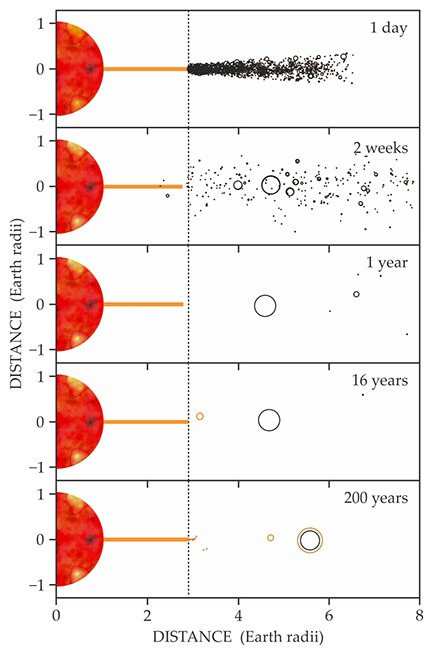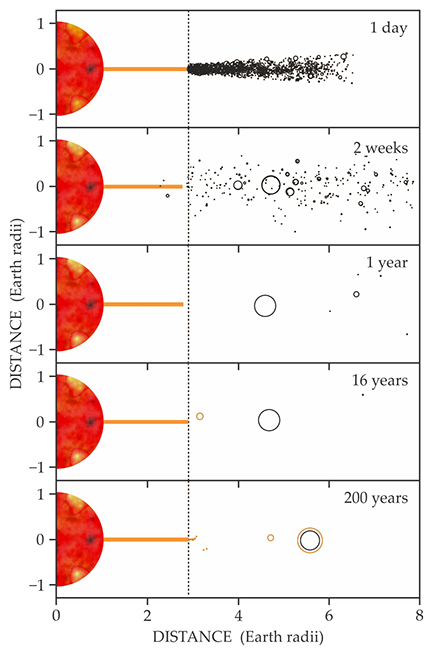Thermodynamic simulations explain the Moon’s composition
DOI: 10.1063/PT.3.3040
It’s widely thought that our Moon emerged out of an oblique collision between Earth and a body the size of Mars (see the article by Dave Stevenson, Physics Today, November 2014, page 32
Early on, researchers suggested that the volatiles may simply have boiled off and been lost as the Moon formed from the hot disk of molten rock and gas launched into Earth orbit, and the idea remained popular for decades. Recent studies, however, have shown that Earth’s gravity and frequent collisions among atoms in the protomoon’s viscous magma prevented their escape.
Using computer simulations that track the thermodynamic evolution of that Earth-orbiting disk, Robin Canup and Julien Salmon of the Southwest Research Institute and their colleagues Bruce Fegley Jr at Washington University in St. Louis and Channon Visscher at Dordt College now quantitatively explain how the depletions could have arisen. 1 In their account, the Moon formed in two distinct accretion stages, separated by a decade or so, that likely produced inner and outer layers with different compositions. Giant impacts were common in our solar system during the final stages of Earth’s evolution 4.5 billion years ago, and knowing how the Moon was made is central to understanding our own and other terrestrial planets.
A lunar two-step
The new work builds on Canup and Salmon’s previous dynamical simulations of the giant impact: 2 As shown in the figure, just 24 hours after the impactor struck, about two lunar masses of material (a mixture of 90% melt and 10% vapor) settled into a planar orbit spanning more than six Earth radii. The massive disk started clumping from local gravitational instabilities in the molten rock. At distances beyond a planet’s so-called Roche limit, self-gravitating satellites retain their integrity against tidal forces. And within weeks any melt that found itself beyond Earth’s Roche limit of 2.9 Earth radii coalesced into thousands of moonlets, each tens to hundreds of kilometers across; the first 40% of the Moon formed within months from those moonlets.

Snapshots of the protolunar disk. Within a day after a giant impact that likely formed our Moon, a disk of molten and vaporized rock orbits an almost completely molten Earth (red) and extends several Earth radii. Beyond the Roche limit of 2.9 Earth radii—the distance at which self-gravitating clumps of molten rock are no longer torn apart by the planet’s tidal forces—outer-disk material (black) can persist and coalesce into moonlets. Inside the Roche limit, inner-disk material (yellow) remains a turbulent liquid–gas mixture a few kilometers wide. Gravitational interactions drive the moonlets outward, where they assemble within months into an object nearly half the mass of the Moon, and compress the disk inward. The confinement stalls the accretion of new moonlets from the inner disk for a decade or so, but much of that inner-disk material eventually accretes onto the Moon until the Moon spirals out of reach of newly spawned moonlets. (Adapted from ref.

Inside the Roche limit, though, any developing clumps were quickly sheared apart. As a result, the inner disk cooled more slowly due to its smaller surface area and local heating. Turbulence caused the inner disk to gradually spread, and as material migrated beyond the Roche limit over the next few centuries, it formed its own moonlets, which were then accreted as the remaining 60% of the Moon.
That migration was initially stalled for about a decade, though, because of gravitational interactions known as orbital resonances between the inner disk and the first batch of moonlets. The moonlets set up density waves in the disk—akin to tidal bulges on Earth—that robbed the disk of angular momentum. The interaction generated a positive torque on the moonlets, which drove them outward, and a negative torque on the inner disk, which contracted its edge and delayed the spawning of new moonlets.
After the lag, the Moon began efficiently accreting melt from the inner disk. But as decades passed and material dissipated, the disk torques weakened, and eventually any newly forming clumps were scattered into high-eccentricity orbits by the Moon and fell back to Earth.
Adding chemistry
The new work tackles the question of how late in the accretion process the volatiles in the inner disk could have cooled enough to become part of the migrating melt that ended up on the Moon. 1 To evaluate the melt’s composition, the team incorporated two additional models into the dynamical simulations. A thermal model estimates the temperature and partial pressure of the clumps as a function of when they form at the Roche limit. A second, chemical model estimates the extent to which various volatile and more refractory elements partition into the melt at the temperature and vapor pressure they experience just prior to reaching the Roche limit.
The researchers found that the clump-formation temperatures remained above the condensation temperature of potassium (about 3000 K at the relevant disk pressures) until at least 98% of the Moon had accreted. The outer roughly 60% of the Moon must therefore have formed from moonlets depleted of potassium, sodium, and their more volatile cousins, such as zinc; that prediction has been borne out by the Apollo samples. By the time those elements were cool enough to appreciably condense, the Moon had spiraled away out of reach.
Water inside the Moon?
The volatile content of the Moon’s deep interior—the part created by the first batch of moonlets—is uncertain. The team says that portion of the Moon should contain the same abundance of volatiles as Earth does, covered by the later accumulation of an overlying 100- to 500-km volatile-poor layer. Assuming that the Moon was never molten enough to stir up its contents and that little gas evaporatively escaped, “there’s really no other place for the volatile elements in the vapor to end up,” says Canup, “since they were already emplaced outside the Roche limit immediately following the giant impact.”
The disk in the team’s new simulations was anhydrous; its two-phase silicate-rock composition supplies all the oxygen required to build a realistic Moon. Nonetheless, the disparate measurements of water content among lunar samples are tantalizing. Whereas most rocks found on the surface are bone dry, glass beads spewed onto the surface by volcanic fountains from the deep interior 3 billion–4 billion years ago contain water concentrations as high as 46 parts per million by mass (see the Quick Study by Lindy Elkins-Tanton, Physics Today, March 2011, page 74
References
1. R. M. Canup et al., Nat. Geosci. 8, 918 (2015). https://doi.org/10.1038/ngeo2574
2. See, for example, J. Salmon, R. M. Canup, Astrophys. J. 760, 83 (2012).https://doi.org/10.1088/0004-637X/760/1/83
3. E. H. Hauri et al., Earth Planet. Sci. Lett. 409, 252 (2015). https://doi.org/10.1016/j.epsl.2014.10.053




